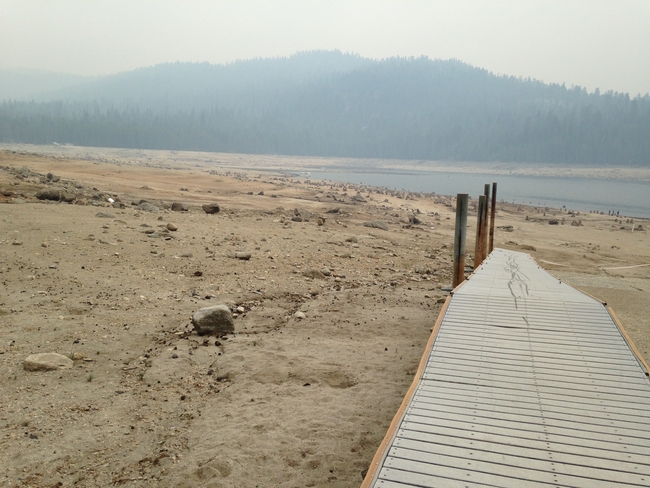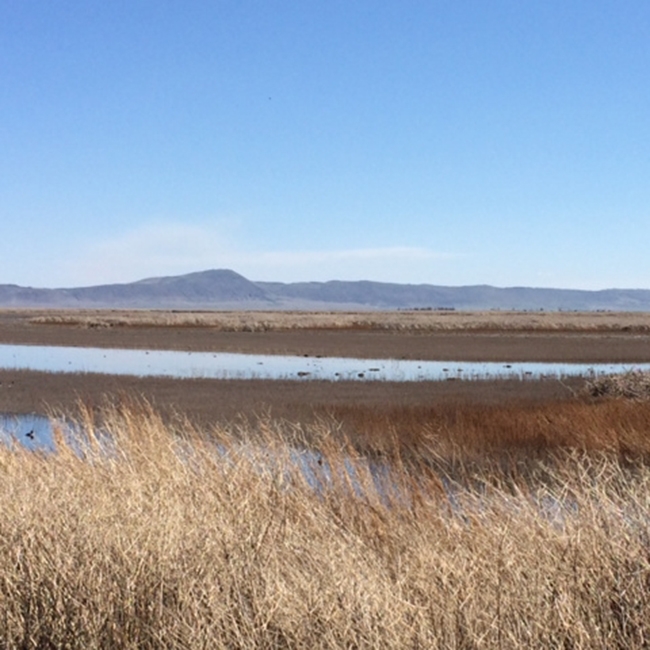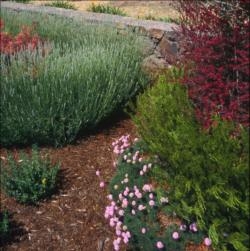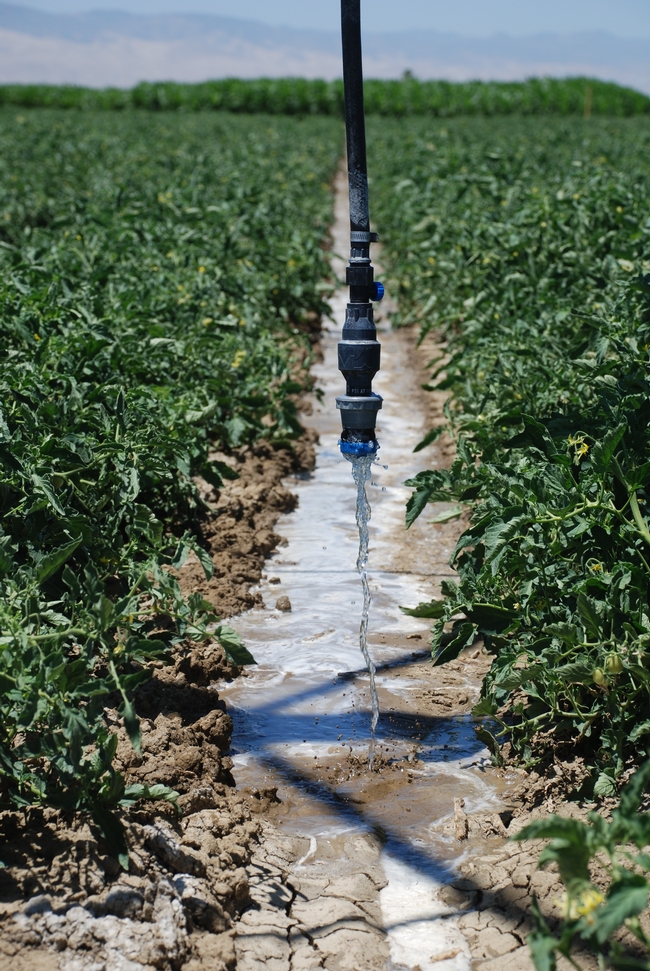Posts Tagged: Water
California drought is depleting the state's groundwater reserves
Nervousness over California's epic drought has given way to alarm, reported Joby Warrick in the Washington Post. Streams and lakes are drying up, and now the aquifers are being pumped at an unsustainable rate.
The massive shift to groundwater has helped farmers survive this year, but a UC Davis study says tapping groundwater at the same rate into the future could soon deplete this valuable resource.
"A well-managed basin is used like a reserve bank account," said Richard Howitt, professor emeritus in the Department of Agricultural and Resource Economics at UC Davis. "We're acting like the super rich who have so much money they don't need to balance their checkbook."
Thomas Harter, UC Cooperative Extension groundwater specialist in the Department of Land, Air and Water at UC Davis, said depleting the aquifer is more serious than depleting water reservoirs because aquifers take far longer to replenish.
"It's a downward path," he said. "We cannot do what we did this year on a permanent basis."
Honey Bees Need Water, Too!
These triple-digit temperatures make us all thirst for water. Honey bees need water, too. If you see them taking a sip from your birdbath or taking...
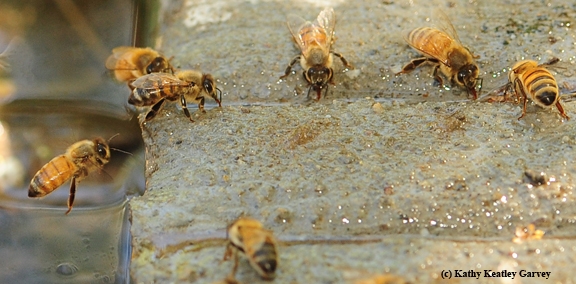
Honey bees find water where they can. (Photo by Kathy Keatley Garvey)
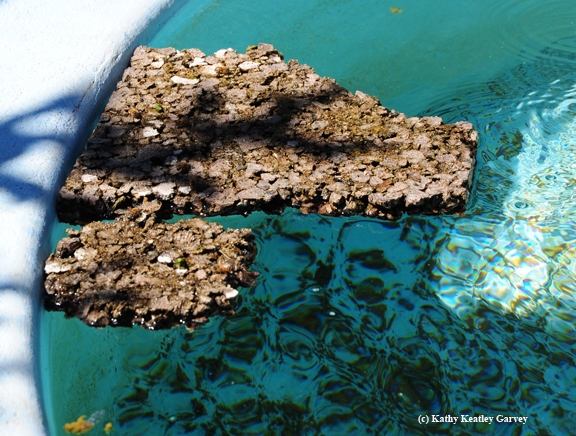
A flat floating cork in the fountain of The Melissa Garden, Healdsburg, is great for bees to buzz down and safely take a sip. (Photo by Kathy Keatley Garvey)
How are you conserving water?
People, animals and plants all need water to survive, yet we have less than 1 percent of the earth's water available for our use. And our water supply is diminishing. This year's record California drought conditions mean that now, more than ever, every drop counts.
The average household uses 30 percent of its water outdoors for landscaping and gardening. Inside the home, the majority is used in the bathroom. Just shortening your daily shower by a minute or two can save as much as 700 gallons of water every month!
Pool your knowledge
On May 8, 2014, we're asking you to tell us what you are doing to conserve water. Have you started to take shorter showers? Invested in low-flow faucets and toilets? Let your grass go brown or swapped it for drought-tolerant landscaping? If you're a farmer, do you use new, higher-efficiency irrigation technology?
Maybe you already are conserving water; maybe you aren't. Either way, we want to know about it—and remember, in a survey like this there's no wrong answer. Your answers will help create a clearer picture of what all of us are doing—and can do—to protect our water resources.
Build a more secure future for you and your community in five simple steps:
STEP 1: On May 8, 2014, go online and visit the map at beascientist.ucanr.edu/water. Click on the picture of the map on the right.
STEP 2: Enter your ZIP Code or zoom to your current location on the map.
STEP 3: Click on your location.
STEP 4: Use the online checklist to select all of the ways you are conserving water in your home, garden, landscape, or on your farm.
STEP 5: Attach a photo showing how you're conserving water!
On May 8, 2014, get out there and be a scientist. Tell us where food is grown in your community. Your answers will help build a healthier future for your community, and for the state.
Other ways to join the fun:
- Are you a teacher? Educator? Parent? Youth group leader? Download our lesson plans and activities from our food activity box.
- Pledge a tweet or Facebook status. Join our Thunderclap campaign and donate a tweet or a Facebook status to #BeAScientist on May 8.
- Join the online conversation by following #BeAScientist on Facebook, Twitter and Instagram.
- Learn more about this project by reading our Fact Sheet.
Earth Day conservation tips come from UCCE
The article focused on the Earth Day festivities at UC Merced, but the water-savings tips came from David Doll, UC Cooperative Extension advisor in Merced County. A large fraction of home water use happens in the yard. Doll said reducing lawn watering time and fixing broken sprinklers are important first steps to water conservation.
Grass lawn can use more water than many agricultural crops - including almonds, walnuts and tomatoes. Generally residents can cut back lawn irrigation and keep it green.
Doll shared a simple test to prevent excessive landscape irrigation. Pinch the soil between the thumb and index finger. If dirt crumbles and falls away, it needs water. But if it forms into a ribbon one-inch wide or longer, it can go another day or two without water, Miller reported.
Water conservation is part of the citizen science project being launched May 8 by UC Cooperative Extension to mark its 100th anniversary. On the Day of Science and Service all Californians are asked to report their water saving strategies. To participate, go to http://beascientist.ucanr.edu.
How are you conserving?
People, animals and plants all need water to survive, yet we have less than 1 percent of the earth's water available for our use. And our water supply is diminishing. This year's record California drought conditions mean that now, more than ever, every drop counts.
Californians currently use an average of 196 gallons of water per person per day, including all business operations other than agriculture. The average household uses 30 percent of its water outdoors for landscaping and gardening. Inside the home, the majority is used in the bathroom. Just shortening your daily shower by a minute or two can save as much as 700 gallons of water every month!
Did you know that if everyone in the state reduced her or his water consumption by 10 gallons a month, California would save a total of 4.56 billion gallons every year?
The University of California is pledging to reduce its water consumption by 20 percent by 2020. Now we want to know, how are you conserving?
On May 8, 2014, we're asking you to tell us what you are doing to conserve water.
Have you started to take shorter showers? Invested in low-flow faucets and toilets? Let your grass go brown or swapped it for drought-tolerant landscaping? If you're a farmer, do you use new, higher-efficiency irrigation technology?
Maybe you already are conserving water; maybe you aren't. Either way, we want to know about it — and remember, in a survey like this there's no wrong answer. Your answers will help create a clearer picture of what all of us are doing — and can do — to protect our water resources.
Build a more secure future for you and your community in five simple steps:
STEP 1
On May 8, 2014, go online and visit the map at beascientist.ucanr.edu/water.
STEP 2
Enter your ZIP Code or zoom to your current location on the map.
STEP 3
Click on your location.
STEP 4
Use the online checklist to select all of the ways you are conserving water.
STEP 5
Attach a photo showing how you're conserving water!
Visit beascientist.ucanr.edu to learn more about this project and record your observations.
For an overview, see the video below:
Content of this post by the education team: Steven Worker, Melissa Womack, Marisa Neelon, Karey Winfield-Royas, Pam Kan-Rice and Jennifer Rindahl. Video production by Alberto Hauffen.


